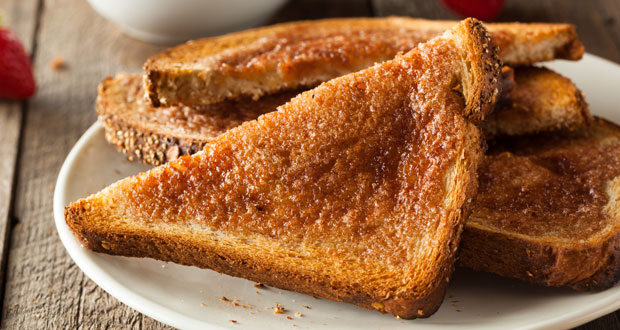Many residents of aged care facilities love having toast for breakfast. What many staff don't realise, though, is that toast is classified as a normal texture food. According to the Australian standardised definitions and terminology for texture-modified foods and fluids, toast is only suitable for people on a normal diet. Surprisingly, bread and toast require the same number of ‘chews’ as raw apple, nuts and steak. Those that aren’t able to chew toast sufficiently are at a high risk of choking.
From a texture point of view, bread and toast are fibrous, generally dry with a low moisture content and can’t be mashed with a fork, which is what is required for a soft food diet texture. Eating toast requires good oral strength and control to chew and swallow. Without this, a person is at increased risk of choking.
To eat bread and toast you must be able to:
- Move the food around in your mouth with your tongue.
- Chew.
- Stop the food from getting stuck on the top of your mouth.
- Moisten the toast and bread with saliva.
- Swallow the food down.
Ideally, a person should have adequate teeth and/or well fitted dentures to chew bread and toast safely. Next time you have a piece of toast, count how many times you chew before you swallow. Concentrate on your chewing and notice how you add moisture. It is added from saliva, sipping a drink or adding butter or spreads? Ask yourself, how do you think someone with a swallowing difficulty would manage toast?
What options are there for people on a soft food diet?
On a normal diet, people can have whatever they choose. While there are restrictions for people on soft diets, there are still plenty of options, some of the popular ones include fish cakes, ravioli, eggs (boiled, scrambled and poached), fritters (or crustless quiche), spongecake with cream, pikelets, pancakes, bananas, mangoes, avocados, zucchini slices, omelettes, marshmallows, sandwiches with soft fillings.
People on a soft diet should not have:
Biscuits (unless dunked in tea to soften), nuts, toast, raw apple, hard and/or crunchy foods, foods that crumble easily, raw vegetables, breads with mixed textures bread rolls with crunchy outside and soft inside), crackers/rice cakes.
Can there be exceptions?
Of course, there are exceptions to every rule. Following an individualised swallowing assessment, a speech pathologist may allow toast for a person on a soft food or texture-modified diet and provide added suggestions that may include cutting crusts off toast, adding extra butter and providing small mouthfuls. Adequate teeth and/or well-fitted dentures are also required to chew bread and toast safely.
Other tips for ensuring safe mealtimes:
- Sitting as close to 90 degrees as possible (this provides good support for food and drink to flow through digestive systems and let gravity take its course).
- Monitor for signs of food and drink going down the wrong way (this is called aspiration: when it heads towards a person’s lungs), including coughing, choking, unusual shortness of breath, red face and/or watery eyes, increased temperature, wet voice.
Bernadette Dutton holds a Bachelor of Speech Pathology from the University of Queensland. She is a certified practicing speech pathologist at Loqui Speech Pathology.
Do you have an idea for a story?Email [email protected]
 Aged Care Insite Australia's number one aged care news source
Aged Care Insite Australia's number one aged care news source

